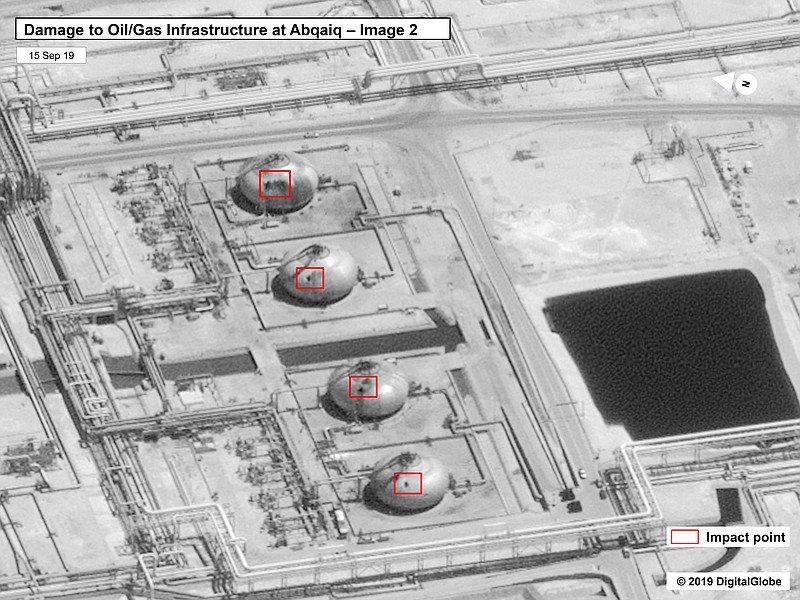DUBAI, United Arab Emirates (AP) — A weekend drone attack on Saudi Arabia that cut into global energy supplies and halved the kingdom’s oil production threatened Sunday to fuel a regional crisis, as the U.S. released new evidence to back up its allegation that Iran was responsible for the assault amid heightened tensions over Tehran’s collapsing nuclear deal.
U.S. Secretary of State Mike Pompeo has blamed Iran for the attack Saturday on key Saudi oil infrastructure. On Sunday, senior U.S. officials again said the American government believes there is no doubt Iran was responsible, saying satellite imagery and other intelligence show the strike was inconsistent with one launched from Yemen, where Iranian-backed Houthi rebels had claimed responsibility.
Iran, meanwhile, called the U.S. claims “maximum lies,” while a commander in its paramilitary Revolutionary Guard reiterated its forces could strike U.S. military bases across the Mideast with their arsenal of ballistic missiles.
The U.S. government produced satellite photos showing what officials said were at least 19 points of impact at two Saudi energy facilities, including damage at the heart of the kingdom’s crucial oil processing plant at Abqaiq. Officials said the photos show impacts consistent with the attack coming from the direction of Iran or Iraq, rather than from Yemen to the south.
Iraq denied Sunday that its territory was used for an attack on the kingdom, and U.S. officials said a strike from there would be a violation of Iraq’s sovereignty.
The U.S. officials said additional devices, which apparently didn’t reach their targets, were recovered northwest of the facilities are being jointly analyzed by Saudi and American intelligence. The officials, who spoke on condition of anonymity to discuss intelligence matters, did not address whether the drone could have been fired from Yemen, then taken a round-about path, but did not explicitly rule it out.
The attacks and recriminations are increasing already heightened fears of an escalation in the region, after a prominent U.S. senator suggested striking Iranian oil refineries in response to the assault, and Iran warned of the potential of more violence.
“Because of the tension and sensitive situation, our region is like a powder keg,” Iranian Brig. Gen. Amir Ali Hajizadeh said. “When these contacts come too close, when forces come into contact with one another, it is possible a conflict happens because of a misunderstanding.”
Actions on any side could break into the open a twilight war that’s been raging just below the surface of the wider Persian Gulf in recent months. Already, there have been mysterious attacks on oil tankers that America blames on Tehran, at least one suspected Israeli strike on Shiite forces in Iraq, and Iran shooting down a U.S. military surveillance drone.
The attack on Saudi Arabia’s Abqaiq plant and its Khurais oil field Saturday led to the interruption of an estimated 5.7 million barrels of crude oil production per day, equivalent to more than 5 percent of the world’s daily supply.
It remains unclear how King Salman and his son, Crown Prince Mohammed bin Salman, will respond to an attack targeting the heart of the Saudi oil industry.
There was no immediate impact on global oil prices from the attacks as markets were closed for the weekend, but analysts anticipate a spike in oil prices when markets reopen today. Saudi Arabia has promised to fill in the cut in production with its reserves, but has not said how long it will take to repair the damage.
Images from the European Commission’s Sentinel-2 satellite examined by the AP showed black char marks at the heart of the Abqaiq plant Sunday, marks not seen over the prior month. Identical marks are visible on the U.S. imagery. The Washington-based Center for Strategic and International Studies in August identified the area with the char marks as the plant’s stabilization area. The center said the area includes “storage tanks and processing and compressor trains — which greatly increases the likelihood of a strike successfully disrupting or destroying its operations.”
The state-run oil giant Saudi Aramco, which the kingdom hopes to offer a sliver of in a public stock offering, did not respond to a request for comment.
Pompeo directly blamed Iran for the Saudi attack on Twitter late Saturday, and officials worked to provide evidence for his claim the following day.
“Amid all the calls for de-escalation, Iran has now launched an unprecedented attack on the world’s energy supply,” Pompeo wrote. “There is no evidence the attacks came from Yemen.”
The U.S., Western nations, their Gulf Arab allies and U.N. experts said Iran supplies the Houthis with weapons and drones — a charge Tehran denies.
U.S. officials previously alleged at least one recent drone attack on Saudi Arabia came from Iraq, where Iran backs Shiite militias. Those militias in recent weeks have been targeted themselves by mysterious airstrikes, with at least one believed to have been carried out by Israel.

